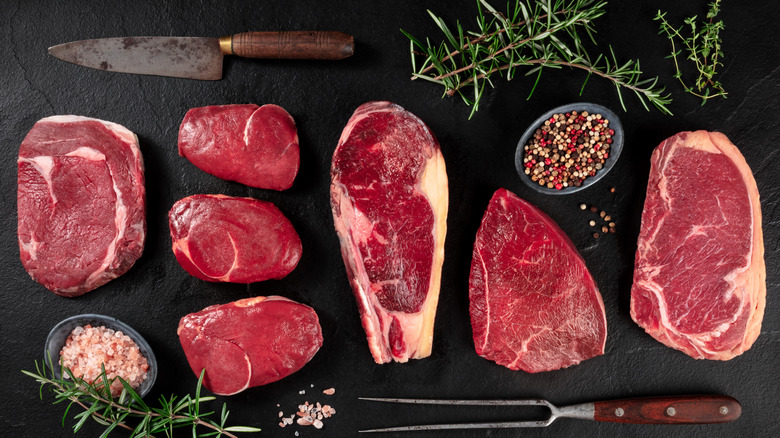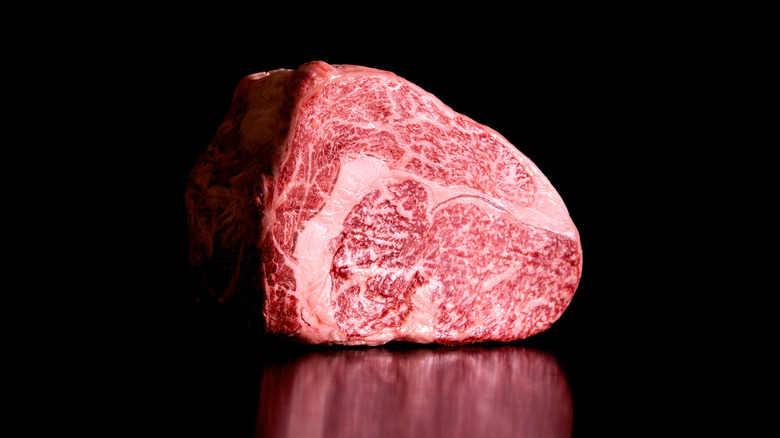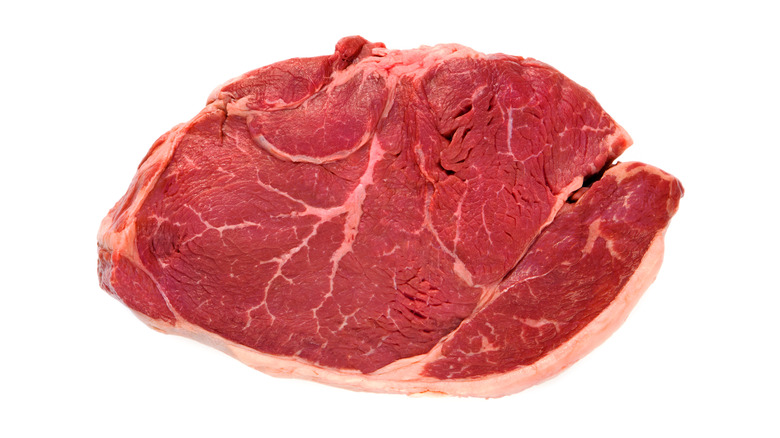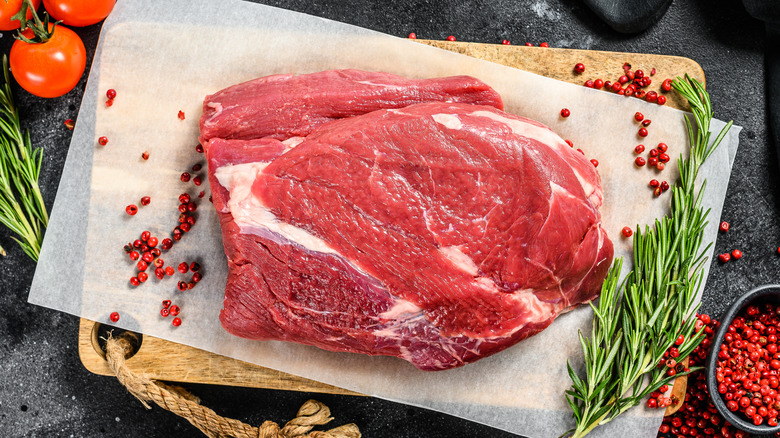Your Quick Guide For Beef Cut Grades
Any steakhouse lover is familiar with the designation of "prime" for a cut of beef, and knows they will be getting a high-quality, juicy steak. Where does the name come from, and how is it determined?
The USDA has a grading system that delineates the quality and safety of beef. All meat is inspected for safety by the USDA, but not all of it is graded. The grades that are given to beef cuts are requested by the meat processor, and will indicate the tenderness of the beef, as well as its level of juiciness and flavor. The grading also takes into account the age of the animal when it was slaughtered, which directly affects tenderness.
There are 8 grades of beef, but the ones consumers will see on a retail package or on a menu are: prime, choice, and select. These grades are decided by the USDA after inspection of the fat marbling in the ribeye muscle, which falls between the 12th and 13th rib of the cow.
The USDA beef cut grades of "prime," "choice," and "select" are the highest grades given out of the eight total grades, and is essentially a ranking of quality, flavor, and price. The grade tells you nothing about the cut, the nutrition of the beef, the feed of the cattle, or how the animal was raised. What is important for beef lovers to know about each level?
Prime beef ranks highest
Cuts of beef labeled "prime" are the best of the best. They take the number one slot in the ranking due to their bountiful marbling. Marbling is the thin white threads of fat you see in meat. The more marbling a cut has, the more tender and juicy it will be when cooked. Unlike fat that falls outside of the cow's muscle that you end up cutting off, marbling will melt as the meat is heated through, imparting moisture and flavor as it cooks.
Prime beef only makes up around 2-5% of all beef cuts sold; it's mostly only found on the menus of fine dining restaurants, hotels, and high-end steakhouses. It comes from young cows whose meat is roughly composed of 8-13% fat. Due to the ample marbling, prime beef is best suited for dry heat cooking methods like grilling, roasting, and broiling. Popular cuts of beef that earn the elusive prime grade include rib roasts and wagyu.
Using the word prime for a cut of beef that has not been officially designated the grade upon USDA inspection is illegal. Rest assured, when you see "prime" on a menu, you are getting the highest quality (and highest priced) cut that is available.
Choice beef takes second place
Choice beef comes in right behind prime beef due to slightly less marbling, with about 4-10% of the meat being composed of fat. It is still a tasty cut of meat, and the most common one you will come across in grocery stores and on restaurant menus. It is tender, flavorful, and juicy, though not quite at the same level as prime. The price on choice cuts of beef is lower than prime, but it is still a high-quality and tasty option. About half of all cattle graded by the USDA earn the title of choice.
Choice cuts that come from the rib or tenderloin of the cow will be more tender, as those muscles are used less often. Such cuts are suited for the same dry-heat cooking methods as prime cuts — grilling, broiling, and roasting. Other choice cuts that are not as tender do well with low-and-slow cooking methods such as braising, slow cooking, simmering in liquid, or roasting at a lower temperature for a longer period of time. Popular cuts that score a choice grade are ribeye and sirloin. The beef from the common Angus cow also tends to earn the "choice" label.
Select beef is the leanest
As that fat marbling equals flavor, select cuts of beef come in last per the USDA consumer grades. Select cuts of beef are the leanest of the three, with only about 2-4% of their meat being fat. Due to this, they are less juicy and flavorful, but are the most affordable of the three grades.
Select beef is still fairly tender and of a quality cut of beef, so it shouldn't be ruled out just because it comes in last. It just needs to be cooked with a method that doesn't dry the meat out. Because of the lower fat content, these cuts of beef do well with a marinade, braising, or quick searing on the grill. A sauce on the side, or cooking it in a liquid, will also help impart some moisture that's missing due to the lack of marbling. It's a great red meat option for those watching their fat intake as well. Popular cuts graded select are brisket, chuck, and shank.



